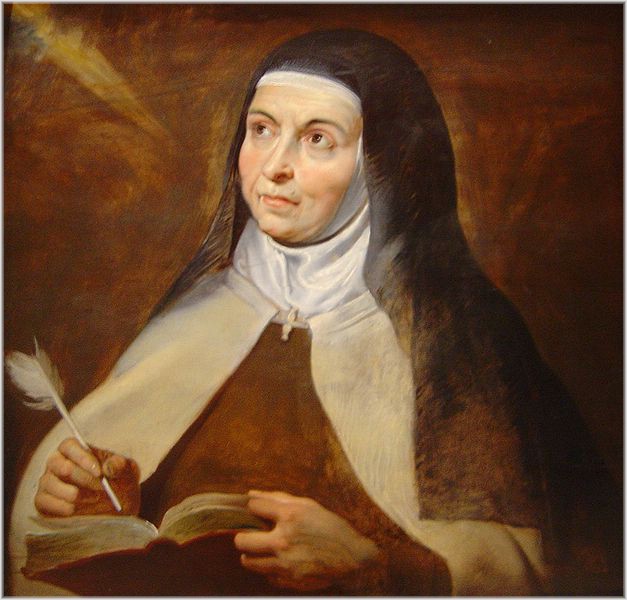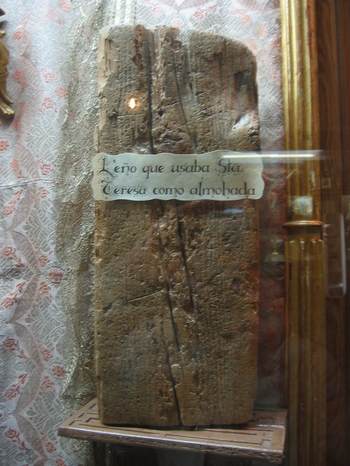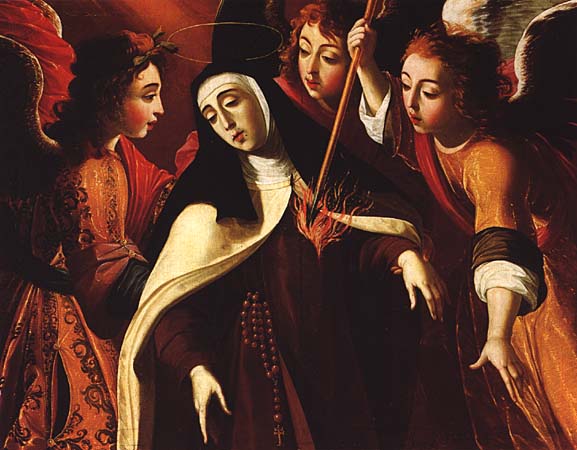The great St Teresa of Avila was born on this day 500 years ago. Happy birthday St Teresa!
St Teresa is, without any doubt, one of the greatest female saints of all time. In fact, she is one of the greatest saints of all irrespective of gender, and is one of that elite group of Doctors of the Church.
Her personality was remarkable and communicates itself so readily through her writings. She had a wonderful biting wit and holy impatience, and sometimes it is hard not to laugh out loud when reading the psychologically astute observations in her writings.
Few saints have shown more courage, fortitude and leadership than she did.
Many saints had a great devotion to Teresa and Fr Doyle was no different. He regularly gave retreats to Carmelite convents, and he referred to her several times throughout his letters, and even fasted at meals on one occasions in her honour. Here is his record of this experience:
I felt urged in honour of St. Teresa to give myself absolutely no comfort at meals which I could possibly avoid. I found no difficulty in doing this for the nine days. I have begged very earnestly for the grace to continue this all my life and am determined to try to do so. For example, to take no butter, no sugar in coffee, no salt, etc. The wonderful mortified lives of these holy nuns have made me ashamed of my gratification of my appetite.
Fr Doyle had a great admiration for St Teresa’s pursuit of holiness and virtue, which in her case really kicked in at about the age of 40.
The life of St. Teresa teaches us that we should never despair of becoming saints. As a child she was filled with a strange mysterious longing for martyrdom. But the early years of her religious life found her cold or tepid in the service of God, indifferent to the sacred duties of her state. The call came. Sweetly in her ear sounded that little voice which too often in other souls has been hushed and stifled. Teresa rose. The past was gone and no lamenting could recall its ill-spent days, but the present was hers, and the future lay before her. Ungenerous in the past, generosity would be her darling virtue; cold and careless, no one would now equal her burning love for her patient outraged Saviour.
Many saints have described mystical experiences involving both spiritual delights and physical pain, especially a kind of mystical wounding of the heart. Saints such as Catherine of Siena, Therese of Lisieux, Pio of Pietrelcina and Philip Neri come to mind. The most famous of all though is St Teresa of Avila. Here is St Teresa’s description of her experience:
It was our Lord’s will that in this vision I should see the angel in this way. He was not large, but small of stature, and most beautiful—his face burning, as if he were one of the highest angels, who seem to be all of fire: they must be those whom we call cherubim. Their names they never tell me; but I see very well that there is in heaven so great a difference between one angel and another, and between these and the others, that I cannot explain it. I saw in his hand a long spear of gold, and at the iron’s point there seemed to be a little fire. He appeared to me to be thrusting it at times into my heart, and to pierce my very entrails; when he drew it out, he seemed to draw them out also, and to leave me all on fire with a great love of God. The pain was so great, that it made me moan; and yet so surpassing was the sweetness of this excessive pain, that I could not wish to be rid of it. The soul is satisfied now with nothing less than God. The pain is not bodily, but spiritual; though the body has its share in it, even a large one. It is a caressing of love so sweet which now takes place between the soul and God, that I pray God of His goodness to make him experience it who may think that I am lying.
Fr Doyle may have experienced something similar to what St Teresa experienced. Here is one excerpt from his writings:
Even as a child I longed and prayed to be a saint. But somehow it always seemed to me as if that longing could never be realised, for I felt there was some kind of a barrier like a high wall between myself and God. What it was, I cannot say even now. But recently this obstacle appears to me to have been removed, the way is open, and I feel I love Jesus now as I never did before, or even hoped to. With this comes the conviction, so strong and consoling with so much peace and happiness, that Jesus will grant my heart’s desire before I die. I dare not put on paper what I feel, even if I could; but at times Jesus seems to pour all the grace of His Sacred Heart upon me, until I am intoxicated almost with His love and could cry out with the pain of that sweet wounding.
When Fr Doyle refers to a “sweet wounding”, is he referring to a specific mystical experience? Perhaps he is writing in a symbolic fashion, but there is a possibility that he is describing an extraordinary mystical phenomenon that we find in the lives of some of the greatest saints.
Here is an excerpt from another one of Fr Doyle’s letters in which he speaks about a kind of spiritual wounding:
What you say is indeed true. Jesus has been “hunting” me during these past days, trying to wound my heart with His arrows of love. He has been so gentle, so patient, tender, loving, I do not know at times where to turn, and yet I somehow feel that much of this grace is given me for others, I know it has helped souls and lifted them close to Jesus.
I long to get back to my little room at night, to calm and quiet, and yet I dread it, for He is often so loving there. I feel He is near because I cannot go to Him in the Tabernacle. It is such a helpless feeling to be tossed about as it were on the waves of love, to feel the ardent, burning love of His Heart, to know He asks for love, and then to realise one human heart is so tiny.
In the later editions of his biography, Alfred O’Rahilly gives us some further tantalising hints about this aspect of Fr Doyle’s spiritual life. Fr Doyle gave spiritual direction to an unnamed nun who O’Rahilly described as a “privileged penitent”. By this he means that she received many graces herself from God. It seems that as well as directing her, Fr Doyle also spoke to her of his own spiritual life. This nun sent the following in a letter to O’Rahilly, presumably in an attempt to explain Fr Doyle’s “wounding”.
In response to inspirations received directly and indirectly from Jesus, he strove, notably for seven or eight years before he died, to ‘put on Jesus Christ’, to model his life on the Priest-Christ, to be, as far as it was humanly possible, ‘another Christ’. This was the secret spring of his holiness. It was not a simple attraction, not a mere fad, but a forming of a life of priestly holiness, distinctly asked for and expressed by Christ. He heard with attention the first invitation: ‘Model your life on Mine, lead a perfect life’. And as if to secure a faithful response, Jesus seemed in the year 1910 to have planted in his heart a spark of divine love. This was the ‘sweet wounding’, a grace like to that received by St Teresa, of which he complained…Jesus infused into his souls some of his own passionate love for souls; and it was this passion that made him seem to do rash things. It was the ‘charity of Christ’ that urged him, and he did nothing through mere caprice or impulse.
Such lofty heights in the spiritual life are hard for most of us to appreciate and understand. There may be extraordinary phenomena in the advanced stages of the spiritual life, and it is surely difficult for our ordinary language to explain them and even more difficult for us to begin to understand them. And perhaps, in this age of doubt and confusion, it may even sometimes be difficult to believe them.
What we can at least say about Fr Doyle is that he received many graces from God (how else could he do what he did?) and that there is evidence which suggests that some of these were very great graces. And if those great graces did actually involve a mystical wounding of his heart, then he is in good company with many of the greatest saints and mystics in the history of the Church, including St Teresa herself. But we may never actually know the truth of the matter, and in any event such a determination is of course not mine to make – it rests with the Church.
One thing that both Fr Doyle and St Teresa had in common was a refreshing humanity and sense of humour – St Teresa said that she despised dour faced saints, and it’s clear that Fr Doyle agreed with her on this. Here is one last quote from Fr Doyle which mentions St Teresa in a humorous context.
I wonder is there a happier man in France than I am. Just now Jesus is giving me great joy in tribulation, though conditions of living are about as uncomfortable as even St. Teresa could wish — perpetual rain, oceans of mud, damp, cold and a plague of rats. Yet I feel that all this is a preparation for the future and that God is labouring in my soul for ends I do not clearly see as yet. Sometimes I kneel down with outstretched arms and pray God, if it is a part of His divine plan, to rain down fresh privations and sufferings. But I stopped when the mud wall of my little hut fell in upon me — that was too much of a good joke!



